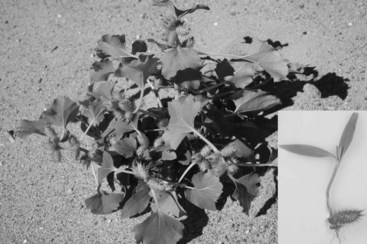Cocklebur Toxicosis
Basic Information 
Epidemiology
Geography and Seasonality
• The most common cocklebur, X. strumarium, is found throughout North America.
• Poisoning in animals occurs most often in the spring and summer when growing conditions favor germination of the seedlings.
• The mature plants are prolific bur producers; consequently, massive numbers of seedlings may germinate at once, increasing the potential for poisoning to occur.
• Cockleburs are annual erect, branching plants up to 6 feet in height with a taproot. The leaves are large and simple and alternate with serrated edges. Flowers are produced in leaf axils or terminally on branches. Characteristic burs turn brown when mature (Figure 1).




